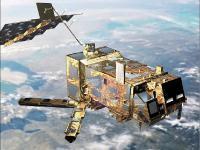METOP (Meteorological Operational) is Europe's first polar-orbiting operational meteorological satellite. It is the European contribution to the Initial Joint Polar System (IJPS), a co-operative agreement between Eumetsat and the US National Oceanic and Atmospheric Administration (NOAA) to provide data for climate and environmental monitoring and improved weather forecasting.
Metop-A (launched on 19 October 2006), Metop-B (launched on 17 September 2012) and Metop-C (launched 7 November 2018) are in a lower polar orbit, at an altitude of 817 kilometres, to provide more detailed observations of the global atmosphere, oceans and continents. The three satellites will operate in unison for as long as Metop-A's available capacities bring benefits to users. NOAA still continues to operate its mid-afternoon orbit satellite service as part of the Polar Orbit Enviromental Satellites (POES) system.
Instruments:
A/DCS (Advanced Data Collection System)
AMSU (Advanced Microwave Sounding Unit)
ASCAT (Advanced Scatterometer)
AVHRR/3 (Advanced Very High Resolution Radiometer)
GOME-2 (Global Ozone Monitoring Experiment-2)
GRAS (GNSS Receiver for Atmospheric Sounding)
HIRS/4 (High Resolution Infrared Sounder)
IASI (Infrared Atmospheric Sounding Interferometer)
MHS (Microwave Humidty Sounder)
SARP/3 (Search And Rescue Processor)
SARR (Search And Rescue Repeater)
SEM-2 (Space Environmental Monitor)
